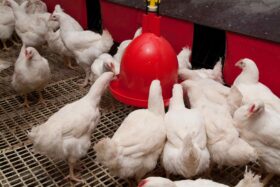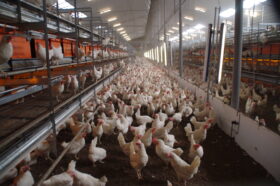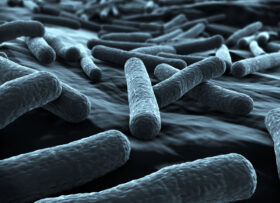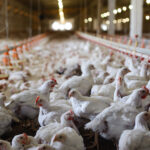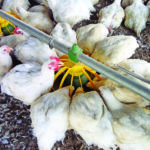Dr Daniel Valbuena, Global Manager of Technical Services, Hy-Line International – Conference Report
Heat stress is one of the major environmental stressors in the poultry industry, especially in regions with high temperatures and high humidity. In EW Nutrition’s Poultry Academy in September, the topic was approached in a comprehensive and practical presentation.
A layer’s normal body temperature is about 40° C. Hens are comfortable with an ambient temperature 18° C to 24° C. When that temperature gets above 32° C, the more serious consequences of heat stress occur.
To mitigate the negative effects of heat stress on bird welfare, production, and profitability, essential best practices include those listed below.
Ventilation
Airflow at the birds’ level is key to removing bird heat. Naturally-ventilated barns are particularly at risk of heat stress. Increase the movement of air in open houses with stir fans. Ensure a minimum velocity of 1.8–2 meters/second in the bird areas.
Clean and ensure function of fan louvers. Fan belts should be tightened or changed to avoid slipping or breaking during periods of high temperature. Poorly maintained fans will operate at 50% reduced efficiency.
Air inlets must be adequate to supply the airflow needed to ventilate the house during warm weather. Inadequate inlet space will throttle down the fans and decrease airflow. Inlets should be kept clean and free of anything that might restrict the flow of incoming air. Use baffle boards to direct incoming air onto the birds. Thermostats should be checked for accuracy. An auxiliary power system must be in place in case of a power outage during hot weather.
In addition to running fans throughout the day when it’s hot, fans should run overnight and early morning to bring in cooler air. Air inlets should be adjusted to achieve uniform airflow throughout the building.
In houses equipped with evaporative cooling systems, the pads should be cleaned or replaced when they become clogged. Water flow over the pads should be uniform with no dry areas. Air will flow preferentially through dry areas since there is less resistance. Clean spider webs and dust from window screens frequently to improve ventilation inside the house.

Fans increase air velocity within the house and create a cooling effect.
Foggers
Fogging or misting is effective at low humidity (<60% relative humidity). Excess moisture in the air from using foggers or misters at high humidity can worsen heat stress conditions.
Foggers or misters need to be checked routinely and should run about 2 minutes out of every 10 if the humidity is low, however, run times can be adjusted based on house temperature and humidity. Fogging the inlet air in negative pressure ventilation systems has a good cooling effect.
Fogging systems should have water filters (to keep nozzles from clogging) and have a positive shutoff to prevent dripping causing wet litter.

Roof design and cooling
Insulated roofs (R28 is recommended) reduce the radiation and conduction of solar heat through the roof to the interior of the house. Reflective roofing materials or light-coloured materials are recommended.
Ensure to provide ridge vents at roof level to allow hot air to exit so that fresh air may enter the house through side openings. The roof should have an overhang (minimum 60 cm) to reduce direct and indirect sunlight getting into the house.
Thatching can provide cost-effective insulation, but may need to be replaced every few years, and is difficult to clean, and may harbor vermin.
Use of shade netting (left) or thatching material such as palm fronds, paddy straw, corn stalks, sugarcane tops (right) to reduce solar heating of the roof.
Using roof sprinklers during times of extremely high temperature can remove heat from the roof and cool the inside of the house.
Curtains
Adjustable, porous side-wall curtains can be used control the flow of air into the house, and protect birds from direct, hot winds. Water dripping onto side curtains can reduce the house temperature.

Porous window shades block direct sunlight from entering the house but allow air to pass through.
Bird handling
Management practices that require bird handling, such as beak trimming, transfer, and vaccinations, should be done in the early morning hours, or in the evening, when it’s not so hot. Heat-stressed birds have decreased immune function and may not respond as well to vaccination. Alternatively, if birds are panting, they may breathe in too much of a spray vaccine or ingest too much of a water-administered vaccine. In both situations, birds may exhibit signs of the disease that the vaccines are intended to prevent.
Stocking density
It’s critical not to overstock cages. If stocking density is high, the radiant heat between the birds accumulates and the temperature increases. Birds need to be able to spread their wings to increase airflow around their bodies. Caged birds are more susceptible to heat stress because they are unable to seek a cooler place and there is less opportunity for conductive heat loss in cages. The temperature within a cage can be much higher than the measured air temperature in the walkway. Increased air velocity within the cages increases the convective heat loss and removes trapped air between birds.
Manure management
Manure allowed to accumulate reduces ventilation in cages. Remove manure from the house before the hot season, if practical. Heat produced during the decomposition of manure contributes to the heat load in the house. The presence of large amounts of manure in shallow pit houses or under cage batteries restricts the movement of air.
Be prepared and anticipate
- The key to minimizing the effects of heat stress is to be prepared and anticipate periods of high environmental temperatures, and implementing appropriate management measures prior to the rise in temperatures. Implement cooling systems, such as evaporative cooling pads, misting systems, or fans. Provide natural or artificial shading within the layer house to reduce direct sunlight exposure. Shade structures, curtains, or baffles can help protect the hens from excessive heat.
- Farm personnel should be trained to recognize and respond to heat stress promptly. You should also have an emergency plan in place for extreme heat events.








